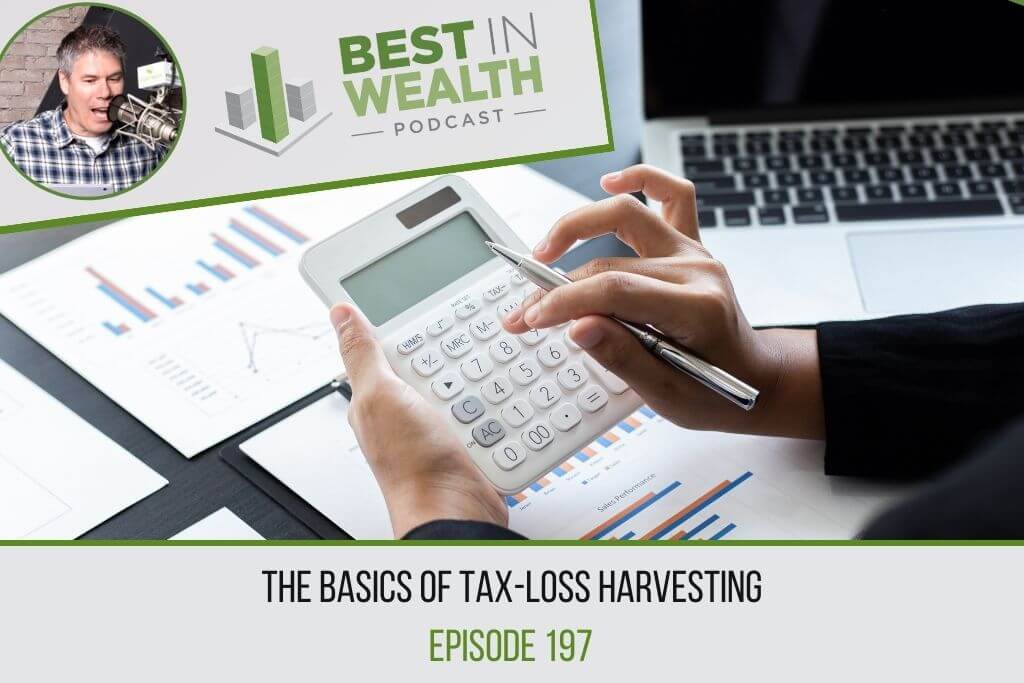The Basics of Tax-Loss Harvesting, Ep #197

We are set to have one of the worst weeks in the stock market in a long time. The stock market was down over 20% the day this podcast was recorded—in bear market territory. We cannot control the market, no matter how much we would like to. But something that we can control—to some extent—is tax-loss harvesting. What is it? How can it help you avoid paying excess taxes? Learn what you need to know in this episode of Best in Wealth.
NOTE: I am not a CPA and this is not formal tax advice but purely informational. Please contact a CPA or reach out to Fortress Planning Group for professional advice.
What is tax-loss harvesting? Learn the basics in this episode of Best in Wealth! #wealth #retirement #investing #PersonalFinance #FinancialPlanning #RetirementPlanning #WealthManagement #Taxes Click To TweetOutline of This Episode
- [1:11] Can you boycott financial news for 30 days?
- [4:28] So just what is tax-loss harvesting?
- [8:03] Two ways tax-loss harvesting helps manage taxes
- [11:40] Two kinds of gains when you sell investments
- [13:28] Gains and losses in mutual funds
- [15:59] The details on wash-sale rules
So just what is tax-loss harvesting?
Tax-loss harvesting can only be conducted in a taxable account—not a retirement account. You can make as many trades as you want in an IRA and it will not impact your taxes today. But if you have an account other than your retirement accounts, you have to pay taxes on dividends you receive. You are obligated to pay taxes when you sell an investment and have a gain and when a mutual fund sends out a distribution.
Tax-loss harvesting can help you reduce taxes now and in the future. How? Tax-loss harvesting allows you to sell investments when they are down, replace them with something similar (but NOT the same), and offset the gains you might have with the losses you are realizing now. The result? Less money goes to taxes and more stays invested and working for you.
Learn what you need to know about tax loss harvesting in this episode of Best in Wealth! #wealth #retirement #investing #PersonalFinance #FinancialPlanning #RetirementPlanning #WealthManagement #Taxes Click To TweetTwo ways tax-loss harvesting helps manage taxes
The first way is that losses can be used to offset gains: If you sell an investment and see $10,000 worth of losses, you can buy something similar to stay in the market. But it cannot be the same or you will not see the benefit of the loss. Now you have $10,000 worth of losses on the books. At some point in the year, other investments spit out dividends or gains. If any gains equal $10,000, they can be offset. No taxes for you!
Or, the losses can offset $3,000 worth of income on a joint tax return in one year. If you realized $10,000 worth of losses and you do not have dividends, gains, or profit from sales, you can use $3,000 to offset $3,000 of income from your job or an IRA distribution. The other $7,000? You can carry it into the next year and the next year until it is depleted.
Two kinds of losses when you sell investments
There are short-term losses and long-term losses. Short-term losses are losses you realize from a sale of an investment that you have owned for less than one year. Long-term losses are losses that are realized after selling investments that you have held for more than one year. The rate at which they are taxed is different.
Short-term gains are taxed as income at your regular tax rate. The top margin of federal tax is 37% for high-income earners. The net investment tax income adds 3.8%—adding up to 40.8%. State and local income taxes can put you in tax rates in excess of 50%.
Long-term capital gains tax is significantly lower. If your taxable income is $80,800 or less, you won’t be taxed on long-term capital gains. If you make up to 500,000, the tax is around 15%. If you make above $500,000, long-term gains are taxed at 20%.
How do gains and losses work with distributions from mutual funds? How does the “wash-sale rule” apply? Listen to the whole episode to learn more!
Please note, while you can do tax-loss harvesting yourself, many people who try their hand at tax-loss harvesting do it incorrectly. Tax-loss harvesting needs to be incorporated into your year-round tax planning and investment strategy.
There are two kinds of gains when you sell investments and each is taxed differently. Learn what this means for tax-loss harvesting in this episode of Best in Wealth! #wealth #retirement #investing #PersonalFinance #FinancialPlanning… Click To TweetResources Mentioned
- Best in Wealth Episode #195
- Best in Wealth Episode #196
Connect With Scott Wellens
- Schedule a discovery call with Scott
- Send a message to Scott
- Visit Fortress Planning Group
- Connect with Scott on LinkedIn
- Follow Scott on Twitter
- Fortress Planning Group on Facebook
Audio Production and Show notes by
PODCAST FAST TRACK
https://www.podcastfasttrack.com
Podcast Disclaimer:
The Best In Wealth Podcast is hosted by Scott Wellens. Scott Wellens is the principal at Fortress Planning Group. Fortress Planning Group is a registered investment advisory firm regulated by the Securities Act of Wisconsin in accordance and compliance with securities laws and regulations. Fortress Planning Group does not render or offer to render personalized investment or tax advice through the Best In Wealth Podcast. The information provided is for informational purposes only and does not constitute financial, tax, investment or legal advice.



